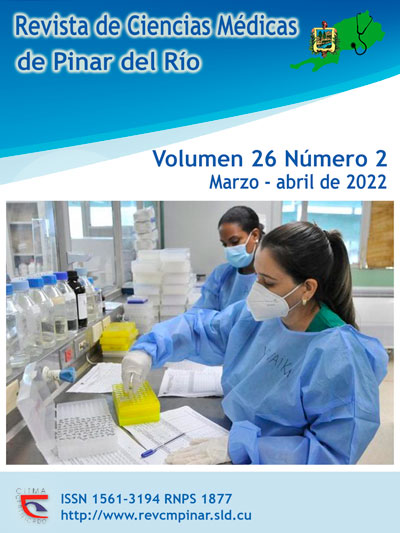Inborn errors of immunity in pediatric oncohematological patients from Pinar del Río
Keywords:
DIAGNOSIS, HEMATOLOGY, ONCOLOGY.Abstract
Introduction: increased susceptibility to infectious processes is considered the main sign suggestive of immunodeficiency; however, other manifestations such as those of hematological and/or oncological nature may be part of the evolution and even the onset of an inborn error of immunity.
Objective: to identify patients with probable diagnosis of inborn errors of immunity in the pediatric oncohematology service at Pepe Portilla Pediatric Provincial Teaching Hospital in Pinar del Rio during the period from January 1979 to March 2021.
Methods: an observational, descriptive, cross-sectional study was carried out with a sample of 103 patients. The following variables were studied: diagnosed oncohematological disease, probable diagnosis of inborn error of immunity and alarm signs of primary immunodeficiency.
Results: the diagnosis of some oncological disease reached 87,4 %. Five patients were found with a probable diagnosis of an inborn error of immunity (Fanconi's anemia and Medullary Aplasia); 54,5 % of non-leukemic patients and only 24,1 % of leukemic patients had at least one and up to three alarm signs for immunodeficiency.
Conclusions: the Jeffrey Modell Foundation alarm signs for the diagnosis of primary immunodeficiencies were not useful in patients with hematopathies; therefore other criteria for the identification of these disorders could be implemented. These patients should be re-evaluated by the provincial immunology group with a view to the diagnosis of inborn errors of immunity and their comprehensive treatment.
Downloads
References
1. Notarangelo LD, Bacchetta R, Casanova JL, Su HC, Branch R, Hospital N, et al. Human Inborn Errors of Immunity: an Expanding Universe. Sci Immunol [Internet]. 2020 [citado 26/1/2022]; 5(49). Disponible en: https://doi.org/10.1126/sciimmunol.abb1662.
2. Solé D. Primary immunodeficiencies : a diagnostic challenge ? J Pediatr (Rio J) [Internet]. 2021 [citado 26/1/2022]; 97(1): S1–2. Disponible en: https://doi.org/10.1016/j.jped.2020.12.002
3. Tangye SG, Al-herz W, Bousfiha A, Chatila T, Cunningham-rundles C. Human Inborn Errors of Immunity: 2019 Update on the Classification from the International Union of Immunological Societies Expert Committee. J Clin Immunol [Internet]. 2020 [citado 26/1/2022]; 40(1): 24–64. Disponible en: https://doi.org/10.1007/s10875-019-00737-x
4. Grumach AS, Goudouris ES. Inborn Errors of Immunity : how to diagnose them ? J Pediatr (Rio J) [Internet]. 2021 [citado 26/1/2022]; 97(Suppl 1): S84--S90. Disponible en: https://doi.org/10.1016/j.jped.2020.11.007
5. Rodrigues G, Segundo S. Genetic-molecular characterization in the diagnosis of primary immunodeficiencies. J Pediatr (Rio J) [Internet]. 2021 [citado 26/1/2022]; 97 (Suppl 1): S3--S9. Disponible en: https://doi.org/10.1016/j.jped.2020.09.007
6. Verhoeven D, Jan A, Meyer-wentrup F, Boes M. Increased risk of hematologic malignancies in primary immunode fi ciency disorders : opportunities for immunotherapy. Clin Immunol [Internet]. 2018 [citado 26/1/2022]; 190: 22–31. Disponible en: http://dx.doi.org/10.1016/j.clim.2018.02.007
7. Maffeis M, Notarangelo LD, Schumacher RF, Soncini E, Soresina A, Lanfranchi A, et al. Primary Immunodeficiencies and Oncological Risk : The Experience of the Children ’ s Hospital of Brescia [Internet]. 2019 [citado 26/1/2022]; 7: 232. Disponible en: https://www.ncbi.nlm.nih.gov/pmc/articles/PMC6593615/
8. Bousfiha A, Jeddane L, Picard C, Al-Herz W, Ailal F, Chatila T, et al. Human Inborn Errors of Immunity: 2019 Update of the IUIS Phenotypical Classification. J Clin Immunol [Internet]. 2020 [citado 26/1/2022]; 40(1): 66–81. Disponible en: https://doi.org/10.1007/s10875-020-00758-x
9. Jeffrey Modell Foundation. 10 Warning Signs of Primary Immunodeficiency [Internet]. 2021 [citado 26/1/2022]. Disponible en: http://downloads.info4pi.org/pdfs/JMF_10Signs_Generic_082421_v2.pdf
10. Abolhassani H, Havoshzadeh Z, Mahdaviani SA, Momen T, Sherkat R, Sadeghi-shabestari M, et al. Global systematic review of primary immunodeficiency registries. Expert Rev Clin Immunol [Internet]. 2020 [citado 26/1/2022]; 16(7): 717-732. Disponible en: https://doi.org/10.1080/1744666X.2020.1801422
11. Abd I, Azman NA, Gennery AR, Mangantig E, Hashim IF, Zainudeen ZT. Systematic Review of Primary Immunodeficiency Diseases in Malaysia : 1979 – 2020. Front Immunol [Internet]. 2020 [citado 26/1/2022]; 11(1923). Disponible en: https://www.frontiersin.org/articles/10.3389/fimmu.2020.01923/full
12. Casado Hernández I. Inmunodeficiencias primarias y citopenias. Rev Cuba Hematol Inmunol y Hemoter [Internet]. 2019 [citado 26/1/2022]; 35(4): 1–17. Disponible en: http://scielo.sld.cu/scielo.php?script=sci_arttext&pid=S0864-02892019000400002
13. Tavares Costa-carvalho B, Sevciovic Grumach A, Franco JL, Espinosa-rosales FJ, Leiva LE, King A, et al. Attending to Warning Signs of Primary Immunodeficiency Diseases Across the Range of Clinical Practice. J Clin Immunol [Internet]. 2014 [citado 26/1/2022]; 34: 10–22. Disponible en: https://doi.org/10.1007/s10875-013-9954-6
14. John Hopkins Medicine. Failure to Thrive [Internet]. John Hopkins Medicine; 2022 [citado 2/2/2022]. Disponible en: https://www.hopkinsmedicine.org/health/conditions-and-diseases/failure-to-thrive
15. MedlinePlus. Failure to thrive [Internet]. MedlinePlus; 2022 [citado 2/2/2022]. Disponible en: https://medlineplus.gov/ency/article/000991.htm
Downloads
Published
How to Cite
Issue
Section
License
Authors who have publications with this journal agree to the following terms: Authors will retain their copyrights and grant the journal the right of first publication of their work, which will be publication of their work, which will be simultaneously subject to the Creative Commons Attribution License (CC-BY-NC 4.0) that allows third parties to share the work as long as its author and first publication in this journal are indicated.
Authors may adopt other non-exclusive license agreements for distribution of the published version of the work (e.g.: deposit it in an institutional telematic archive or publish it in a volume). Likewise, and according to the recommendations of the Medical Sciences Editorial (ECIMED), authors must declare in each article their contribution according to the CRediT taxonomy (contributor roles). This taxonomy includes 14 roles, which can be used to represent the tasks typically performed by contributors in scientific academic production. It should be consulted in monograph) whenever initial publication in this journal is indicated. Authors are allowed and encouraged to disseminate their work through the Internet (e.g., in institutional telematic archives or on their web page) before and during the submission process, which may produce interesting exchanges and increase citations of the published work. (See The effect of open access). https://casrai.org/credit/



